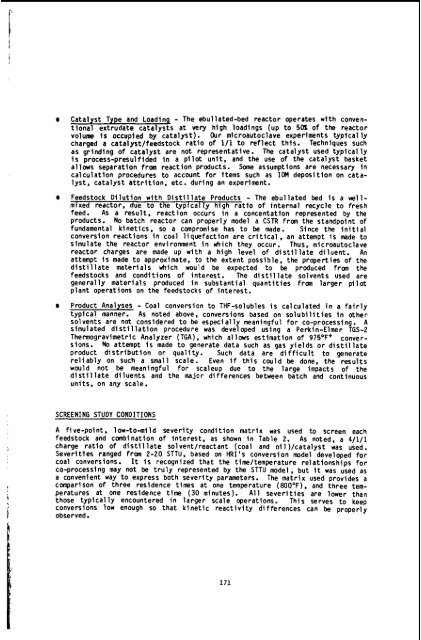Liquefaction co-processing of coal shale oil at - Argonne National ...
Liquefaction co-processing of coal shale oil at - Argonne National ...
Liquefaction co-processing of coal shale oil at - Argonne National ...
You also want an ePaper? Increase the reach of your titles
YUMPU automatically turns print PDFs into web optimized ePapers that Google loves.
C<strong>at</strong>alyst Type and Loading - The ebull<strong>at</strong>ed-bed reactor oper<strong>at</strong>es with <strong>co</strong>nven-<br />
tional extrud<strong>at</strong>e c<strong>at</strong>alysts <strong>at</strong> very high loadings (up to 50% <strong>of</strong> the reactor<br />
volunre is occupied by c<strong>at</strong>alyst). Our microautoclave experiments typical ly<br />
charged a c<strong>at</strong>alyst/feedstock r<strong>at</strong>io <strong>of</strong> 1/1 t o reflect this. Techniques such<br />
as grinding <strong>of</strong> c<strong>at</strong>alyst are not represent<strong>at</strong>ive. The c<strong>at</strong>alyst used typically<br />
is process-presulfided in a pilot unit, and the use <strong>of</strong> the c<strong>at</strong>alyst basket<br />
allows separ<strong>at</strong>ion from reaction products. Some assumptions are necessary in<br />
calcul<strong>at</strong>ion procedures to ac<strong>co</strong>unt for items such as IOM deposition on c<strong>at</strong>a-<br />
lyst, c<strong>at</strong>alyst <strong>at</strong>trition, etc. during an experiment.<br />
Feedstock Dilution with Distill<strong>at</strong>e Products - The ebull<strong>at</strong>ed bed is a well-<br />
mixed reactor, due to the typically high r<strong>at</strong>io <strong>of</strong> internal recycle to fresh<br />
feed. As a result, reaction occurs in a <strong>co</strong>ncent<strong>at</strong>ion represented by the<br />
products. No b<strong>at</strong>ch reactor can properly model a CSTR from the standpoint <strong>of</strong><br />
fundamental kinetics, so a canpranise has to be made. Since the initial<br />
<strong>co</strong>nversion reactions in <strong>co</strong>al liquefaction are critical, an <strong>at</strong>tempt is made to<br />
simul<strong>at</strong>e the reactor environment in which they occur. Thus, microautoclave<br />
reactor charges are made up with a high level <strong>of</strong> distill<strong>at</strong>e diluent. An<br />
<strong>at</strong>tempt is made to approxim<strong>at</strong>e, to the extent possible, the properties <strong>of</strong> the<br />
distill<strong>at</strong>e m<strong>at</strong>erials which would be expected to be produced from the<br />
feedstocks and <strong>co</strong>nditions <strong>of</strong> interest. The distill<strong>at</strong>e solvents used are<br />
generally m<strong>at</strong>erials produced in substantial quantities from larger pilot<br />
plant oper<strong>at</strong>ions on the feedstocks <strong>of</strong> interest.<br />
Product Analyses - Coal <strong>co</strong>nversion to THF-solubles is calcul<strong>at</strong>ed in a fairly<br />
typical manner. As noted above, <strong>co</strong>nversions based on solubilities in other<br />
solvents are not <strong>co</strong>nsidered to be especially meaningful for <strong>co</strong>-<strong>processing</strong>. A<br />
simul<strong>at</strong>ed distill<strong>at</strong>ion procedure was developed using a Perkin-Elmer TGS-2<br />
Thermogravimetric Analyzer (TGA), which a1 lows estim<strong>at</strong>ion <strong>of</strong> 975OF+ <strong>co</strong>nversions.<br />
No <strong>at</strong>tempt is made to gener<strong>at</strong>e d<strong>at</strong>a such as gas yields or distill<strong>at</strong>e<br />
product distribution or quality. Such d<strong>at</strong>a are difficult to gener<strong>at</strong>e<br />
reliably on such a small scale. Even if this <strong>co</strong>uld be done, the results<br />
would not be meaningful for scaleup due to the large impacts <strong>of</strong> the<br />
distill<strong>at</strong>e diluents and the major differences between b<strong>at</strong>ch and <strong>co</strong>ntinuous<br />
units, on any scale.<br />
SCREENING STUDY CONDITIONS<br />
A five-point. low-to-mild severity <strong>co</strong>ndition m<strong>at</strong>rix was used to screen each<br />
feedstock and <strong>co</strong>mbin<strong>at</strong>ion <strong>of</strong> interest, as shown in Table 2. As noted, a 4/1/1<br />
charge r<strong>at</strong>io <strong>of</strong> distill<strong>at</strong>e solvent/reactant (<strong>co</strong>al and <strong>oil</strong> )/c<strong>at</strong>alyst was used.<br />
Severities ranged frm 2-20 STTU, based on HRI's <strong>co</strong>nversion model developed for<br />
<strong>co</strong>al <strong>co</strong>nversions. It is re<strong>co</strong>gnized th<strong>at</strong> the time/temper<strong>at</strong>ure rel<strong>at</strong>ionships for<br />
<strong>co</strong>-<strong>processing</strong> may not be truly represented by the STTU mdel, but it was used as<br />
a <strong>co</strong>nvenient way to express both severity parameters. The m<strong>at</strong>rix used provides a<br />
<strong>co</strong>mparison <strong>of</strong> three residence times <strong>at</strong> one temper<strong>at</strong>ure (8OO0F), and three tem-<br />
per<strong>at</strong>ures <strong>at</strong> one residence time (30 minutes). All severities are lower than<br />
those typically en<strong>co</strong>untered in larger scale oper<strong>at</strong>ions. This serves to keep<br />
<strong>co</strong>nversions low enough so th<strong>at</strong> kinetic reactivity differences can be properly<br />
observed.<br />
171

















